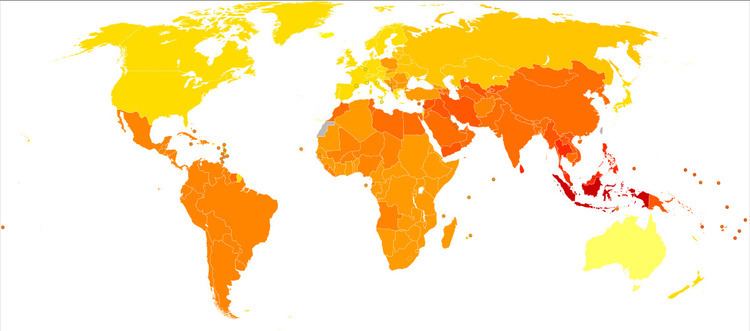 | ||
Schizophrenia affects around 0.3–0.7% of people at some point in their life, or 21 million people worldwide as of 2011 (about one of every 285). By using precise methods in its diagnosis and a large, representative population, schizophrenia seems to occur with relative consistency over time during the last half-century.
Contents
While it is claimed that schizophrenia occurs at similar rates worldwide, its prevalence and incidence varies across the world, within countries, and at the local and neighborhood level. It causes approximately 1% of worldwide disability-adjusted life years (DALYs). The rate of schizophrenia varies up to threefold depending on how it is defined.
By age and gender
Schizophrenia is diagnosed 1.4 times more frequently in males than females, and typically appears earlier in men—the peak ages of onset are 20–28 years for males and 26–32 years for females. Onset in childhood is much rarer, as is onset in middle- or old age.
Generally, the mean age of first hospital admission for treatment of schizophrenia is between 25 and 35. Studies have suggested that lower income individuals tend to have their disorder diagnosed later after the onset of symptoms, relative to those of better economic standings. As a result, the lower social classes are more likely to be living with their illness untreated.
It is generally accepted that women tend to present with schizophrenia anywhere between 4–10 years after their male counterparts. However, using broad criteria for diagnosing schizophrenia shows that males have a bimodal age of onset, with peaks at 21.4 years and 39.2 years old, while females have a trimodal age of onset with peaks at 22.4, 36.6, and 61.5 years old.
This additional post-menopausal peak of late-onset schizophrenia in women calls into question the etiology of the disease and raises a debate about "subtypes" of schizophrenia, with men and women being susceptible to different types (see Causes of Schizophrenia). This is further supported by the variability in presentation of the disease between the genders.
Other theories that may explain this difference include protective or predisposing factors in men or women that may render them more (or less) susceptible to the disease at different points in life. For example, estrogen may be a protective factor for women, as estradiol has been found to be effective in treating schizophrenia when added to antipsychotic therapy.
By country
In 2000, the World Health Organization found the prevalence and incidence of schizophrenia to be roughly similar around the world, with age-standardized prevalence per 100,000 ranging from 343 in Africa to 544 in Japan and Oceania for men and from 378 in Africa to 527 in Southeastern Europe for women.
However, the impact of schizophrenia tends to be highest in Oceania, the Middle East, and East Asia, while the nations of Australia, Japan, the United States, and most of Europe typically have low impact. Despite relative geographical proximity, the DALY rate of schizophrenia in Indonesia nearly doubles that of Australia (the nations with the highest and lowest respective DALY rates). Discrepancies between DALY rates and prevalence may arise from differences in availability of medical treatment: years lived with mental disorders carry significantly higher DALY values when unmedicated than when medicated.
The following tables record the age-standardised disability-adjusted life years rates per 100,000 inhabitants (recorded in 2004).
United States
In 2010, there were approximately 397,200 hospitalizations for schizophrenia in the United States. About 88,600 (22.3%) were readmitted within 30 days.
